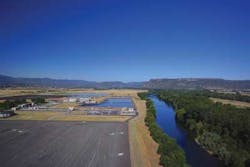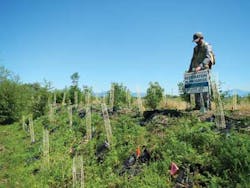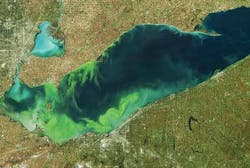By Art Haddaway
Every day, utilities are required to meet certain water quality standards that involve preserving and cultivating their local environment, economy and public health by limiting the amount of nutrients such as nitrogen and phosphorus discharged into watersheds from their sites.
These guidelines include various pollution control and compliance measures, such as the Clean Water Act (CWA) and the National Pollutant Discharge Elimination System (NPDES), imposed by federal and state environmental protection agencies. Primarily issued to publically owned treatment works (POTWs), these permits are designed to not only minimize contaminants in facilities' effluent but also prevent them from infiltrating water resources.
The preemptive methods necessary to meet these benchmarks, however, can become very costly and energy-consuming, given the rise in nutrients being discharged into waterways as well as the heightened enforcement of stricter standards to combat this problem. From installing new nutrient-removal technologies to upgrading aging systems and infrastructure, utilities are routinely faced with these challenges.
"Strict new limits are showing up in those permits around the country," said David Primozich, senior director of ecosystem services at The Freshwater Trust, "and they will require that regulated entities take action to minimize the inputs of phosphorus, nitrogen and temperature in their effluent. In many cases, the costs of reducing those particular water quality constituents are very high."
According to the Environmental Protection Agency (EPA), nutrient pollution is one of the most widespread, costly and challenging environmental problems facing America today. Further, the Agency affirmed that states have identified around 15,000 waterbodies across the nation as containing one or more nutrient-related impairments.
Likewise, Hannah Mellman, manager of legislative affairs at the National Association of Clean Water Agencies (NACWA), stated in a recent article that "more than 60 percent of the rivers and bays in every coastal state are moderately to severely degraded by nutrient pollution, and nutrients are contributing to some of the largest algal blooms, fish kills, shellfish poisonings, and aquatic dead zones in the country."
To address this, POTWs are looking to alternative approaches such as water quality trading as a more economical and cost-efficient method to reduce the presence and discharge of nutrients originating from their facilities.
Water quality trading is an effective strategy designed to help facilities within watersheds meet and maintain water quality regulations at significantly lower costs by employing a system through which pollutant reduction credits are voluntarily bought, sold or exchanged. Embracing a market-based approach, this process provides those utilities that have higher control costs the opportunity to purchase reductions from those with lower costs; therefore, those sources that spend more save money, and those that spend less earn revenue.
"Water quality trading essentially markets pollution reduction, looks at where the lowest cost reductions can be manufactured, puts a price on them, and allows a permitted entity - a public wastewater treatment plant for example - to purchase cheaper pollution reductions from an outside source rather than making more costly reductions at the plant," said Mellman. "This achieves the same level of pollution reduction while saving ratepayers money."
Water quality trading primarily occurs between two point sources (regulated facilities, POTWs, etc.) or between a point and non-point source (unregulated agricultural land, residential area, etc.) and is based on the theory that the required levels of pollutant reduction are achievable and that those sources must work together to diminish as much pollution as possible in order to reach the total reduction needed.
Trading is also centered on the concept that the costs to control the same contaminants within a watershed often vary with each pollution source, and a certain number of credits are allocated to each of them. As such, those sources coexisting within the same watershed can choose to pollute under their limit and sell their credits or pollute over their limit and purchase credits, according to an article by The New Jersey Agricultural Experiment Station of Rutgers University.
"The lens through which we see water quality trading is simply a way to enable regulated entities to invest their compliance resources in things that will have the greatest ecological benefit," said Primozich. "We see the value of dispersed restoration action in the places where resources need it, compared to very expensive technology solutions that have limited environmental benefits."
Water quality trading also works best when there are certain drivers such as limits set by a Total Maximum Daily Load (TMDL) or other regulations that concentrate on source growth, cost savings or environmental stewardship. Further, they are often based on location, number of sources, amount of pollutants discharged, and condition of regulations.
"Trading not only requires TMDLs, but they have to be thoughtfully constructed and meaningfully implemented because it requires the point-source drivers," said Mindy Selman, senior associate and water quality team lead for the Water Resource Institute. "So if the TMDLs don't translate into a cap of the regulated sources, there's generally not going to be a driver for trading."
Along with helping point sources meet nutrient load requirements at lower costs, water quality trading provides many ancillary benefits as well, including the construction of vegetation buffers to minimize agricultural runoff into watersheds. This also contributes to the preservation and development of wildlife habitats, improved flood management, carbon sinks for greenhouse gases, enhanced biodiversity, and better temperature control through shade - all contributing to cost reductions and energy efficiency. "If you're building a riparian buffer, it has a lot of other co-benefits," said Selman. "It creates a more holistic and green approach to solving these sorts of problems."
In the Chesapeake Bay for example - one of the largest trading areas in the country stretching 64,000 square miles and containing several river basins where the bartering takes place - water quality trading could result in a 20- to 80-percent reduction in restorations, according to a study by the Chesapeake Bay Commission. The study also indicated that the Bay could save up to $1 billion per year toward upgrading facilities and controlling pollution; it could also save millions more by planting vegetation or creating wetlands to offset pollution caused by growth and new development.
Trading also encourages camaraderie between watershed sources and emboldens farmers and agricultural areas to participate in the process, given that many of them, particularly in the Midwest, have experienced significant droughts in recent years and need to conserve costs. Likewise, since most of their operations go unregulated, it also prompts them to preserve the terrain. "Trading incentivizes farmers to adopt more nutrient-responsible practices, like using fertilizer with less nitrogen or planting cover crops that prevent topsoil from washing away easily, by paying them for the nutrient reductions they achieve," said Mellman.
While there are many benefits to water quality trading, the process is very complex and requires universal compliance among all parties involved, including watershed stakeholders, federal and state regulatory agencies, the public, and the sources themselves. Likewise, the practice demands trust and commitment among participants given that it's a voluntary endeavor.
Accordingly, the process of trading involves determining the level of need for restoration and what is required to meet the regulatory obligations within a watershed. It also entails measuring the probability of achieving those goals within a certain timeframe as well as weighing a project's costs and security.
"The challenge will be to find those agreements among regulated entities, regulators, environmental advocates, and the public on how to account for the ecological value, or actual numeric reduction, that will occur from a range of dispersed restoration actions," said Primozich.
Mellman added, "There's so much uncertainty that goes into what a credit is worth and what a credit really means. In the end, we need to know that these reductions are being made, and utilities need to know that the credits they're purchasing are really worth what they say they are."
Being a market-based process mainly regulated on the local level, water quality trading hasn't received many federal or state directives, with the exception of EPA's Water Quality Trading Policy from 2003, which outlines recommended guidelines the Agency deems appropriate that watershed sources can follow.
Recently, however, the EPA and the U.S. Department of Agriculture (USDA) have partnered to support water quality trading and other market-based approaches to water quality stewardship. Both organizations are striving to identify opportunities that help improve trading programs across the country through cooperative management and technical assistance, all with the goal of advancing resource management and public services as well as accelerating implementation. As noted by Mellman, "The EPA supports trading as long as the practices uphold the Clean Water Act."
The U.S. Water Alliance held a national roundtable on water quality trading in June that convened key policy makers, industry leaders, and agriculture and environmental groups to discuss the status of trading based on growing needs, new technologies, developing standards, and greater transparency and accountability.
"It's moving toward coalescing around some shared principles and best practices," said Selman. "We're now building on a decade of experience with these trading programs, and it's probably going to become easier; there are going to be more best practices and a lot more standards on how these trading programs should work, so it's not everybody starting from scratch."
Primozich added, "The future of trading will be dependent on building security for regulated entities and regulators that ensures the public's interest in clean water being protected. Regulated entities need to have confidence that by choosing a trading solution, they aren't likely to find themselves in violation of their permits or subjected to third-party lawsuits. The way to avoid that is to have an agreed-upon set of standards and a system that is credible and transparent."







